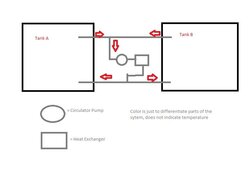All good plans of mice and men......
While laying out my pipes, I decided to measure up the area I'm going to put my non-pressurized heat storage tank. I'm building out of wood and using a liquid paint-on rubber for waterproofing.
I realized, I don't really have the room for an 8 x 4 tank without it getting in the way. I can, however, put in 2 4 x 4 tanks right around the corner from each other. I'm already planning on using some brass thru-hulls to tie the heat exchanger into my system, and I was thinking I could put a pipe between the tanks to keep the water level equal between the two, and pump from one tank, through the heat exchanger, and into the other tank. Since water likes to "find it's own level" so to speak, the second pipe would act as a return between the tanks.
The problem I'm finding is that I think I'd end up with a HUGE temperature difference between the two tanks. Any ideas on how I could get the tanks to equalize in temperature? The only thing I can think would be to use a "T" before and after the pump/exchanger. Similar to this drawing. Does this seem like it makes sense to people, and do you think it would stay relatively equal in temperature? (sorry for the crummy drawing, only have paint at home)

While laying out my pipes, I decided to measure up the area I'm going to put my non-pressurized heat storage tank. I'm building out of wood and using a liquid paint-on rubber for waterproofing.
I realized, I don't really have the room for an 8 x 4 tank without it getting in the way. I can, however, put in 2 4 x 4 tanks right around the corner from each other. I'm already planning on using some brass thru-hulls to tie the heat exchanger into my system, and I was thinking I could put a pipe between the tanks to keep the water level equal between the two, and pump from one tank, through the heat exchanger, and into the other tank. Since water likes to "find it's own level" so to speak, the second pipe would act as a return between the tanks.
The problem I'm finding is that I think I'd end up with a HUGE temperature difference between the two tanks. Any ideas on how I could get the tanks to equalize in temperature? The only thing I can think would be to use a "T" before and after the pump/exchanger. Similar to this drawing. Does this seem like it makes sense to people, and do you think it would stay relatively equal in temperature? (sorry for the crummy drawing, only have paint at home)


